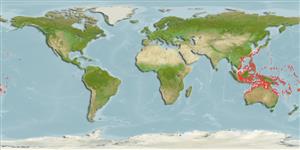>
Eupercaria/misc (Various families in series Eupercaria) >
Lethrinidae (Emperors or scavengers) > Monotaxinae
Etymology: Gymnocranius: Greek, gymnos = naked + Greek, kranion = skull (Ref. 45335).
More on author: Günther.
Environment: milieu / climate zone / depth range / distribution range
Écologie
marin récifal; non migrateur; profondeur 15 - 50 m (Ref. 2295). Tropical; 35°N - 28°S, 105°E - 170°W
Western Pacific: including southern Japan, South China Sea, Australia, Coral Sea, New Caledonia, and Tonga. Recently reported from Norfolk Island (Ref. 8881).
Taille / Poids / Âge
Maturity: Lm ? range ? - ? cm
Max length : 45.0 cm TL mâle / non sexé; (Ref. 2295); common length : 35.0 cm TL mâle / non sexé; (Ref. 2295)
Épines dorsales (Total): 10; Rayons mous dorsaux (Total): 9-10; Épines anales 3; Rayons mous anaux: 9 - 10.
Occurs over sand and rubble areas adjacent to rock and coral reefs in lagoons and outer slopes (Ref. 9775, 90102). Feeds on bottom-dwelling gastropods. Also caught with bottom longlines and handlines (Ref. 9775). Marketed fresh.
Life cycle and mating behavior
Maturité | Reproduction | Frai | Œufs | Fécondité | Larves
Carpenter, K.E. and G.R. Allen, 1989. FAO Species Catalogue. Vol. 9. Emperor fishes and large-eye breams of the world (family Lethrinidae). An annotated and illustrated catalogue of lethrinid species known to date. FAO Fish. Synop. 125(9):118 p. Rome: FAO. (Ref. 2295)
Statut dans la liste rouge de l'IUCN (Ref. 130435)
Menace pour l'homme
Harmless
Utilisations par l'homme
Pêcheries: intérêt commercial mineur
Plus d'informations
Noms communsSynonymesMétabolismePrédateursÉcotoxicologieReproductionMaturitéFraiRassemblement de ponteFéconditéŒufsDéveloppement de l'œuf
RéférencesAquacultureProfil d'aquacultureSouchesGénétiqueElectrophoresesHéritabilitéPathologiesTraitementNutrientsMass conversion
Outils
Articles particuliers
Télécharger en XML
Sources Internet
Estimates based on models
Preferred temperature (Ref.
123201): 24.3 - 28.9, mean 27.6 °C (based on 408 cells).
Phylogenetic diversity index (Ref.
82804): PD
50 = 0.5010 [Uniqueness, from 0.5 = low to 2.0 = high].
Bayesian length-weight: a=0.01905 (0.01079 - 0.03365), b=2.97 (2.82 - 3.12), in cm total length, based on LWR estimates for this species & (Sub)family-body (Ref.
93245).
Niveau trophique (Ref.
69278): 3.8 ±0.0 se; based on diet studies.
Generation time: 5.0 ( na - na) years. Estimated as median ln(3)/K based on 2
growth studies.
Résilience (Ref.
120179): Milieu, temps minimum de doublement de population : 1,4 à 4,4 années (K=0.22-0.24).
Fishing Vulnerability (Ref.
59153): Moderate vulnerability (40 of 100).
Nutrients (Ref.
124155): Calcium = 34.4 [17.3, 63.5] mg/100g; Iron = 0.479 [0.264, 0.793] mg/100g; Protein = 19.6 [17.6, 21.6] %; Omega3 = 0.127 [0.074, 0.185] g/100g; Selenium = 32.5 [19.8, 56.2] μg/100g; VitaminA = 75.8 [23.9, 221.7] μg/100g; Zinc = 1.08 [0.78, 1.48] mg/100g (wet weight);
